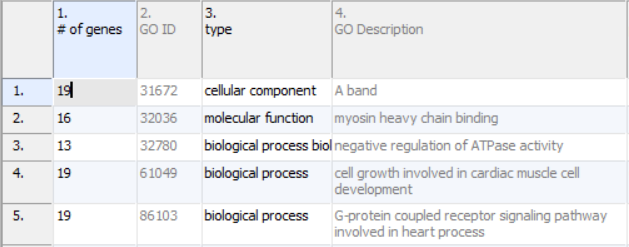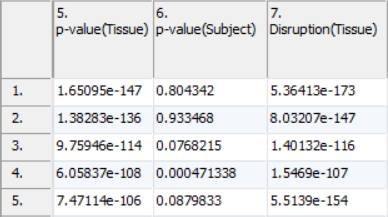GO ANOVA output is very similar to standard ANOVA output except each row in the resulting sheet contains statistical results from a single GO functional group rather than a single gene. Columns can be broken down into four sections:
- Annotations contain detail about the category being considered
- ANOVA results contain the significance of the effect of the factors in the model
- Contrast results contain significance and fold change of the difference between groups compared via contrast
- F-ratios display the significance of the factors in the ANOVA model
Annotations
Annotations will take up the first four columns of the results sheet (Figure 1). The first column (# of genes) is the number of genes in the GO category. Specifically, this is not necessarily the number of unique genes in the category; depending on the technology, it can be the number of probes or probe sets on the microarray whose targets fall into the GO category. Genes targeted more than once will be counted more than once. The second column (GO ID) is the unique numeric identifier of the GO category; it is sometimes useful for searching with when the GO category has a very long name. The third column is the type of the GO category, while the fourth column (GO Description) is the name of the GO category.
ANOVA Results
ANOVA results will include a column for each factor in the setup (Figure 2). A column with the name of the factor or interaction followed by p-value will contain how significant the effect of the variable is on the data. A lower p-value corresponds with a more significant effect. For example, a p-value of 0.1 for tissue means that given the difference between the tissue and the inherent variability of the measurements of the genes in the functional group, there is a 10% likelihood that the tissues are equivalent. A p-value of 0 occurs when the value is too small to be displayed. This can be caused by a very low estimate of inherent variability due to either a very small number of replicates or severely unbalanced data.
In the example experiment, a low p-value for tissue would imply the functional group is differentially expressed across tissues.
A low p-value for an interaction implies that the effect of one factor on the other is significant. In the example dataset, no interactions between two main variables were included as factors. To illustrate what the interaction p-value would mean, consider the case that a drug compound and a control injection were dosed over several time points and an interaction between injection compound and time point was included in the GO ANOVA. A low p-value for the drug-time point interaction corresponds to the effect of drug on the functional group being altered with time.
Additional Assistance
If you need additional assistance, please visit our support page to submit a help ticket or find phone numbers for regional support.


| Your Rating: |
    
|
Results: |
    
|
0 | rates |

